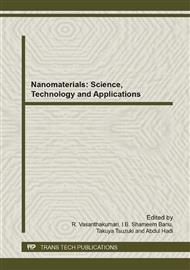[1]
Y. Xia, P. Yang, Y. Sun, Y. Wu, B. Mayers, B. Gates, Y. Yin, K. Kim and H. Yan, One-Dimensional Nanostructures: Synthesis, Characterization, and Applications, Adv. Mater. 15 (2003) 353–389.
DOI: 10.1002/adma.200390087
Google Scholar
[2]
W. Q. Peng, G. W. Cong, S. C. Qu, and Z. G. Wang, Synthesis and photoluminescence of ZnS: Cu nanoparticles, Opt. Mater. 29 (2006) 313–317.
Google Scholar
[3]
C. Bouvy, F. Piret, W. Marine, B. L. Su, Preparation, photoluminescent properties and quantum size effect of ZnS nanoparticles @ mesoporous silica CMI-1, Chemical Physics Letters. 433 (2007) 350-354.
DOI: 10.1016/j.cplett.2006.11.085
Google Scholar
[4]
D. Son, D. Jung, R. Kim, T. Moon, C. Kim, and B. Park, Synthesis and photoluminescence of Mn-doped zinc sulfide nanoparticles, Appl. Phys. Lett. 90 (2007) 101910.
DOI: 10.1063/1.2711709
Google Scholar
[5]
A. M. Kapitonov, A. P. Stupak, S. V. Gaponenko, E. P. Petrov, A. L. Ragach, A. Eychmiiller, Luminescence Properties of Thiol-Stabilized CdTe Nanocrystals, J. Phys. Chem. B. 103 (1999) 10109.
DOI: 10.1021/jp9921809
Google Scholar
[6]
X. D. Wang, Y. Ding, C. J. Summers, and Z. L. Wang, Large-Scale Synthesis of Six-Nanometer-Wide ZnO Nanobelts, J. Phys. Chem. B. 108 (2004) 8773-8777.
DOI: 10.1021/jp048482e
Google Scholar
[7]
A. Narayanaswamy, H. Xu, N. Pradhan, M. Kim, and X. Peng, Formation of nearly monodisperse In2O3 nanodots and oriented-attached nanoflowers: hydrolysis and alcoholysis vs pyrolysis. Journal of American Chemical Society. 128 (2006) 10310-10319.
DOI: 10.1021/ja0627601
Google Scholar
[8]
Bhoopendra Dhar Diwan, Size Effect on the Cohesive Energy of Palladium Nanopar ticle, Journal of Computational and Theoretical Nanoscience. 10 (2013) 2779–2781.
DOI: 10.1166/jctn.2013.3278
Google Scholar
[9]
Bhoopendra Dhar Diwan and N. Kumar Swamy, Dependency of Thermo-Physical Properties on Surface Bonding of BN Nano-crystal, International Journal of Modern Physics: Conference Series. 22 (2013) 525–529.
DOI: 10.1142/s2010194513010611
Google Scholar
[10]
Xiao Hai, Tahir-Kheli Jamil and A. William, Accurate Band Gaps for Semiconductors from Density Functional Theory, J. Phys. Chem. Lett. 2 (2011) 212–217.
DOI: 10.1021/jz101565j
Google Scholar
[11]
I. N. Remediakis and Efthimios Kaxiras, Electronic and optical properties of strained quantum dots modeled by 8-band kp theory, Physical Review B. 59 (1999) 5688–5701.
DOI: 10.1103/physrevb.59.5688
Google Scholar
[12]
Baset Somaye, Akbari Hossein, Zeynali Hossein, Shafie Morteza, Size measurement of metal and semiconductor nanoparticles via UV-Vis absorption spectra, Digest Journal of Nanomaterials and Biostructures. 6-2 (2011) 709 – 716.
Google Scholar
[13]
Baojie Yan, Guozhen Yue, L. Sivec, Chun-Sheng Jiang, Yanfa Yan, K. Alberi, J. Yang, S. Guha, Photovoltaic Specialists Conference (PVSC) proceedings, Honolulu (HI). 0160-8371, (2010).
DOI: 10.1109/pvsc.2010.5616075
Google Scholar
[14]
Debjit Kar and Debajyoti Das, Wide band gap nanocrystalline silicon carbide thin films prepared by ICP-CVD, AIP Conf. Proc. 1512 (2012) 646-647.
DOI: 10.1063/1.4791203
Google Scholar
[15]
Purabi Gogoi, Himanshu S. Jha, Pratima Agarwal, High band gap nanocrystallite embedded amorphous silicon prepared by hotwire chemical vapour deposition, Thin Solid Films. 518 (2010) 6818–6828.
DOI: 10.1016/j.tsf.2010.06.040
Google Scholar
[16]
B. Rezguia, A. Sibaia, T. Nychyporuka, O. Martya, M. Lemitia and Georges Brémonda, Bandgap Engineering of Silicon Quantum Dot Nanostructures for High Efficient Silicon Solar Cell: The Tandem Approach, MRS Proceedings. N08-04 (2008) 1121.
DOI: 10.1557/proc-1121-n08-04
Google Scholar
[17]
Chang-Hee Cho, Baek-Hyun Kim, Sang-Kyun Kim, and Seong-Ju Park, Characterization of electronic structure of silicon nanocrystals in silicon nitride by capacitance spectroscopy, Applied Physics Letters. 96 (2010) 223110.
DOI: 10.1063/1.3431572
Google Scholar
[18]
Bhoopendra Dhar Diwan and Vinod Kumar Dubey, Size Dependence Effective Band Gap in GaSb Nano-solid, AIP Conf. Proc. 1536 (2013) 279.
DOI: 10.1063/1.4810209
Google Scholar
[19]
Y. Kayanuma, Quantum-size effects of interacting electrons and holes in semiconductor microcrystals with spherical shape, Phys. Rev. B. 38-14 (1988) 9797-9805.
DOI: 10.1103/physrevb.38.9797
Google Scholar
[20]
C. Kittel, Introduction to Solid State Physics 6th Ed., New York: John Wiley, (1986).
Google Scholar
[21]
Frank Blatt, J. Modern Physics, McGraw-Hill, (1992).
Google Scholar


